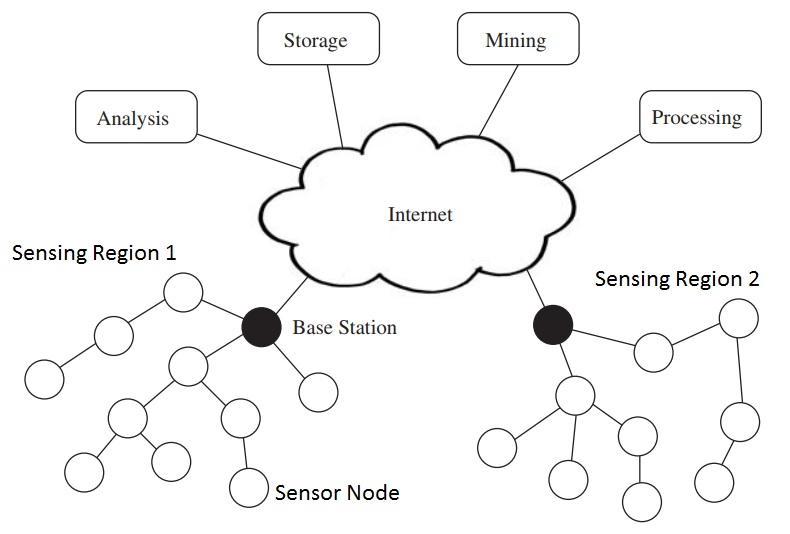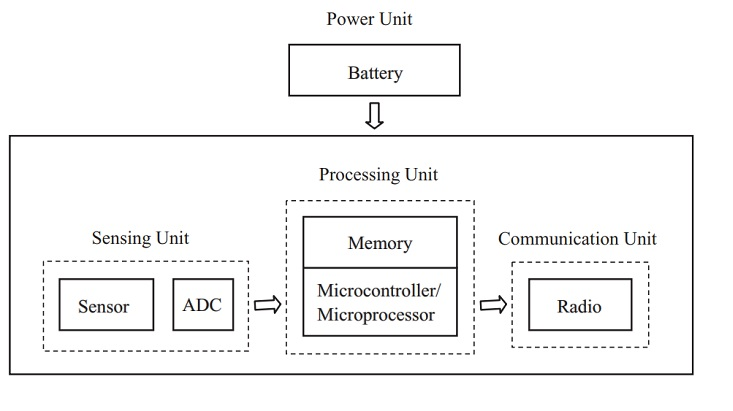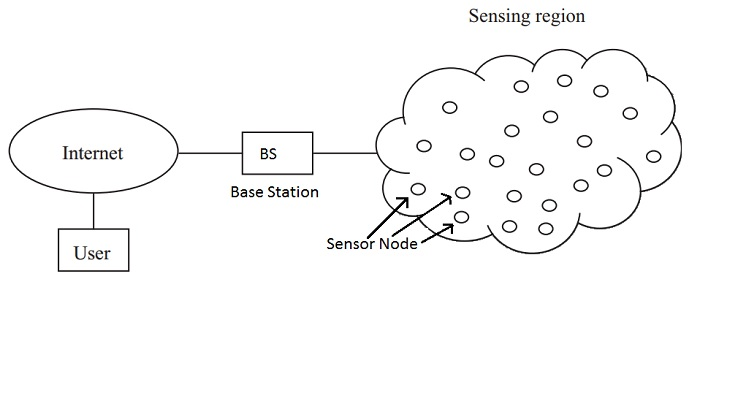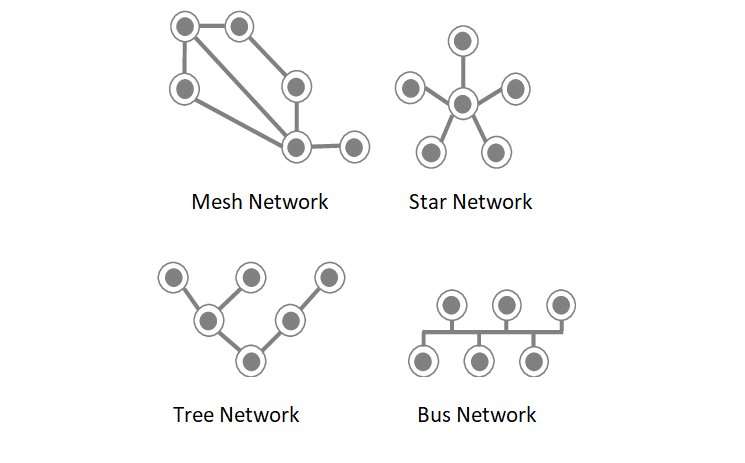WSN, an acronym for Wireless Sensor Networks, detects and responds to physical and environmental conditions, such as heat, pressure, light, etc., via its sensor network.
Advancements in wireless technology and Micro Electro Mechanical System (MEMS) sensors made smart deployment of low-power sensors over a wide area possible, creating inexpensive WSNs for military and civilian applications.
In the below section, we will discuss types of WSNs, their components and applications, and their advantages and disadvantages and applications.
What Is the Meaning of a Network?

Networking links devices that allow for exchanging information and resource sharing. These integrated devices use communication protocols such as TCP/IP, UDP, FTP, HTTP, SMTP, etc., which are a set of rules for transmitting data across wireless or wired networks.
Basically, there are two types of networks: wired and wireless. Wired and wireless networks differ based on data transfer speed, data security, communication range, and cost.
A wired network is categorized by the interconnection of devices through physical cables, while wireless networks depend on radio waves for device connectivity. There are various wireless technologies available such as Wi-Fi, Bluetooth, etc.
Wireless Sensor Network (WSN), as the name states, is a wireless technology, and communication takes place through radio signals.
What is a Wireless Sensor Network (WSN)?
A Wireless Sensor Network, also called WSN, is a collection of specialized sensors arranged at different locations in specific structures to record and monitor physical environmental parameters and organize the resultant data at a centralized location.
These physical parameters include but are not limited to temperature, pressure, wind, and humidity, among other factors.

A WSN network comprises base stations and nodes positioned at different locations, which interact wirelessly. The WSN structure can be implemented using four distinct approaches, namely point-to-point, star, tree, and mesh types.
A WSN arrangement can be categorized into five types based on the physical environment: underground, terrestrial, underwater, multimedia, and mobile WSNs.
New sensor designs use engineering and technology advancements to bridge physical and digital realms for efficient results.
WSN consists of nodes with sensors detecting physical and environmental changes that transmit data to a base station for analysis and output reports.
Integrating Wireless Sensor Networks with GPS or RFID can enhance coverage and create sophisticated tracking or monitoring systems.
WSNs aim to gather environmental information to enhance safety, productivity, and accident prevention while protecting the environment.
Components of a WSN
Let’s see the list of components that make a WSN. Majorly there are two parts in WSN: Sensor Node and Network Architecture.
Sensor Node
The sensor node consists of below components:
- Power Supply: To power all components of the network.
- Sensing Unit: It consists of Sensor and ADC (Analog to Digital Converter). The sensor gathers analog data, and ADC changes it to digital format. Sensor Nodes not only has sensing feature but also does processing, communication, and storage components. Sensor Node collects and analyzes physical data and correlates and fuses it with data from other sensors.
- Processing Unit: Consists of Memory and Microprocessor. It Intelligently processes and manipulates data.
- Communication System: A radio system for data transmission and reception.
- Base Station: It is an extraordinary node with high computational energy and processing capability.

Cluster head: It is a high bandwidth sensing node used to perform data fusion and data aggregation functions in WSN. Based on the system requirements and applications, more than one cluster head will be inside the cluster.
In a Wireless Sensor Network (WSN), a sensor node communicates with other sensor nodes deployed in large areas to monitor the physical environment and a Base Station (BS) via wireless communication. The Sensor nodes collect data and send it to the base station. Base stations process the data and share updated information with users online.
Network Architecture
When all sensor nodes are connected to the base station, it is called Single-hop network architecture. When data is transmitted over long distances, it consumes more energy than data collection and computation, so in such cases, multi-hop network architecture is commonly used by employing intermediate nodes instead of a singular link connecting the sensor node to the base station.

There are two ways to implement these structures: Flat network architecture and Hierarchical network architecture.
In Flat architecture, the base station commands all sensor nodes, and sensor nodes respond via peer nodes using a multi-hop path.
In Hierarchical network architecture, Cluster heads receive information from a group of sensor nodes and relay data to the base station.
Other components of WSN
- Relay node: A midway node is used to communicate with the adjacent node. It enhances network reliability and does not have a process sensor or control equipment.
- Actor node: A high-end node is used to perform and construct a decision depending on the application requirements. Typically, these nodes are resource-rich devices outfitted with high-quality processing capabilities, high transmission power, and battery life.
- Gateway: Gateway is an interface between sensor networks and outside networks. Compared with the sensor node and cluster head, the gateway node is most powerful regarding program and data memory, the processor used, the transceiver range, and the possibility of expansion through external memory.
Types of Wireless Sensor Networks (WSN)
There are five different types of WSN:
- Underwater: Underwater wireless sensor network uses sensor nodes and vehicles below the water to gather data. It has high latency and sensor malfunctions issues and has limited non-rechargeable batteries.
- Underground: This type monitors underground conditions because they work entirely underground, and Sink nodes placed above ground transmit data to the base station. It costs more than terrestrial networks due to expensive equipment and maintenance.
- Terrestrial: This type of network is used on land to monitor different areas’ environmental conditions. Thousands of wireless sensor nodes in Terrestrial WSNs are deployed in an ad hoc or pre-planned structure to communicate with base stations efficiently.
- Multimedia: WSNs can track and monitor multimedia events like video, imaging, and audio. They have affordable sensor nodes with cameras and microphones that wirelessly connect, retrieve, compress, and correlate data.
- Mobile: Mobile WSNs consist of sensor nodes that can move and communicate while performing sensing functions. Mobile wireless sensor networks offer more flexibility, broader coverage, better channel capacity, and save energy compared to stationary sensor networks.
The deployment of the WSN type is based on the application and ground requirements.
Different Structures of WSNs
There are four types of Network structures, but their implementation affects latency, capacity, and robustness as the data routing and processing changes with different Network structures. So, the assessment of the requirements and the nature of the application should be known before deploying the WSN structure.
The nodes can also be linked to the internet and transfer data to the cloud platform for further analysis.

- Point-to-point or Bus Structure: Sensors in this network can communicate directly with each other without any central hub. This structure is widely used and provides secure communication.
- Star Structure: Star network uses a base station as a central hub to communicate with all sensors, and it is simple to implement and requires low power. One of the drawbacks of this structure is a dependency on a single base station for communication.
- Tree or Hybrid Structure: It comprises point-to-point and star structures. In this structure, sensors are arranged in a tree-like configuration, and data transmission occurs through branches between them. It uses less energy than other structures.
- Mesh Structure: In this structure, the data transmission occurs between Sensors within their transmission ranges for multi-hop communication without the need for a central base station. Sensors can use intermediate Sensors to transmit data to Sensors outside their radio coverage area. Hence it is known for scalability and redundancy. It is considered the most reliable as there is no singular point of failure, but it requires more power.
Applications of WSN
WSNs are widely used across numerous sectors where measuring, tracking, or surveillance is required. They spread across an area, measuring temperature, sound, and other parameters in diverse applications.

- They are employed to monitor regions by deploying sensors to detect intrusion attempts, so they are widely used in the military to detect hostile invasions.
- They are popular among civilian applications such as mining, healthcare, surveillance, agriculture, and other monitoring conditions.
- Wireless sensor nodes detect parked vehicles via magnetometers, while micro-radars and magnetometers can be used for tracking.
- WSN is very popular in Environmental/Earth monitoring and sensing, such as Natural disaster prevention, Landslide detection, Water quality monitoring, Forest fire detection, and Habitat monitoring. Also widely regarded across industrial monitoring solutions such as Machine health, wastewater, structural health, etc.
Advantages and Disadvantages of Wireless Sensor Networks
In this section, we will take a look at the advantages and disadvantages of WSN:
Advantages
- WSNs are preferred over wired monitoring systems due to their convenience, reliability, affordability, and ease of deployment.
- WSN eliminates the need for cables or wires.
- WSNs’ proficiency is due to many factors: sensing precision, coverage range, fault tolerance, connectivity, low human involvement, functionality in challenging conditions, and dynamic sensor scheduling.
- Enables centralized monitoring of all nodes within the WSN.
- Adaptable to physical partitions without any problem.
- Routing protocols to communicate in a limited performance and bandwidth environment, creating self-organizing ad hoc networks that use multi-hop communication.
- It uses wireless technology-based security algorithms to create a reliable network for users.
- Allows easy integration of new nodes or devices for scalability.
Disadvantages
- WSNs face challenges like limited bandwidth, high energy consumption, expensive node costs, deployment models, and hardware/software design constraints.
- Wireless sensor networks are susceptible to hacking.
- WSNs are designed for low-speed applications and unsuitable for high-speed communication.
- Expensive to build WSN networks.
- The entire network may shut down in star topology-based WSNs if the central node fails.
Learning Resources
#1. Building Wireless Sensor Networks Using Arduino
A book on building a wireless, low-power network with Arduino and XBee equipment. It includes explanations on developing complex projects through illustrative examples. The book provides detailed pictures and screenshots and explains a home automation project that can be followed as it is or customized.
| Preview | Product | Rating | |
|---|---|---|---|

|
Building Wireless Sensor Networks Using Arduino (Community Experience Distilled) | Buy on Amazon |
You will learn how to wirelessly connect Arduino boards using XBee modules and control the environment based on feedback from network sensors. Use XCTU software on Windows, OS X, or Linux for sensor data collection and storage in a cloud platform or personal database. Also, interact with ZigBee Home Automation devices.
This book can be used by embedded system developers and enthusiasts with Arduino understanding to expand their projects using wireless tech.
#2. Building Wireless Sensor Networks: with ZigBee, XBee, Arduino, and Processing
This book emphasizes building a ZigBee network using XBee radios and Arduino costing under $100. Create adjustable sensing and actuation systems and gain knowledge of XBee intricacies like power management and source routing. Develop gateways for interconnection with adjacent networks, including the Internet.
| Preview | Product | Rating | |
|---|---|---|---|

|
Building Wireless Sensor Networks: with ZigBee, XBee, Arduino, and Processing | Buy on Amazon |
This book will help diverse individuals gain knowledge and skills to pursue their projects by following the examples in each chapter, including inventors, hackers, crafters, students, hobbyists, and scientists.
It is a great resource for creating smart interactive gadgets, and sensor systems are available by utilizing the ZigBee wireless networking protocol and Series 2 XBee radios.
#3. Industrial Wireless Sensor Networks (IWSN): Protocols and Applications
This publication presents new research findings on industrial wireless sensor networks. The papers included in the Special Issue contribute to advancing research on IWSNs and are expected to inspire further research and deployment.
| Preview | Product | Rating | |
|---|---|---|---|

|
Industrial Wireless Sensor Networks: Protocols and Applications | Buy on Amazon |
IWSNs are crucial due to the rising use of wireless sensor networks in daily life and industry, which have high robustness, reliability, and timeliness standards in every network layer.
#4. Building Wireless Sensor Networks with ESP32 LoRa
This guide is to implement a basic Wireless Sensor Network (WSN) with ESP32 on the LoRa network.
| Preview | Product | Rating | |
|---|---|---|---|

|
Building Wireless Sensor Networks with ESP32 LoRa | Buy on Amazon |
It covers various subjects such as preparing the development environment, configuring ESP32 LoRa, sending and receiving data, handling LoRa receiver interrupt, broadcasting messages on the LoRa network, and creating a WSN application with ESP32 LoRa.
Final Words
Wireless sensor networks (WSN) have become vital for various monitoring and tracking applications. The WSN has progressed from basic sensor monitoring to advanced sensing, processing, and analysis.
WSN technology has transformed significantly to gather valuable knowledge and provide desired results.
Next, check out the working of the TCP/IP protocol architecture model.

